“Gardening adds years to your life and life to your years.”
Imagine a garden filled with colorful flowers, the aroma of fresh air, and the chirping of birds! Isn’t it enough to make you calm and joyful?
But what if you can add a unique touch of fire to it? Sounds stupid, right?
Don’t worry! We are just talking about the flowers that look like fire. Yes, you can pick some smoky, flammable bursts of color from the basket of nature and create the illusion of blazing fire in your garden. So, let’s wander through the list of flame-like flowers before the blooming season passes and acknowledge that these elegant flowers will be able to make it to your custom keychains.
15 Best Flowers That Look Like Fire
These are the top fire-like flowers, which use color schemes, petals, and angles to resemble fire and produce amazing visual effects:
Flame Lily
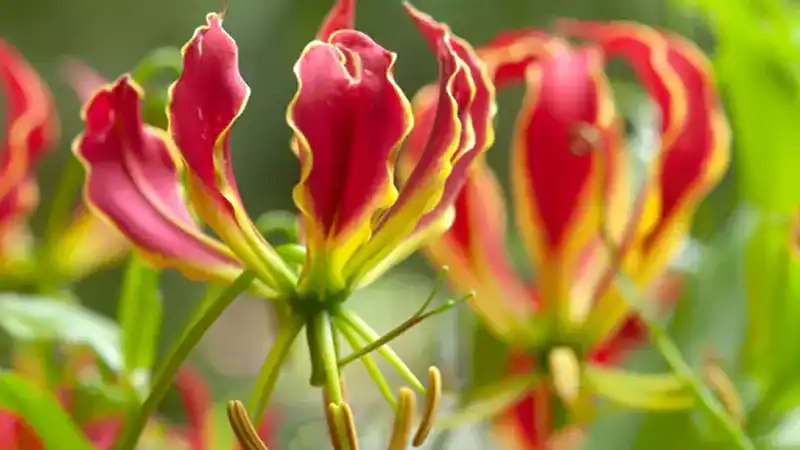
Flame Lily is the queen plant on this list because of its trumpet-like shape. They have a dramatically inverted flame appearance with a deep orange hue and yellow tips. These flowers bloom from late spring to late fall and can add mesmerizing beauty to your garden.
| Common Name | Gloriosa lily, climbing lily, fire lily, flame lily, glory lily |
| Botanical Name | Gloriosa superba |
| Plant Family | Colchicaceae |
| Plant Type | Herbaceous, perennial |
| Mature Size | 5-6 ft. tall, 1-3 ft. wide |
| Native Regions | Africa, Asia |
| Toxicity | Highly toxic to humans and pets |
Flame Peony
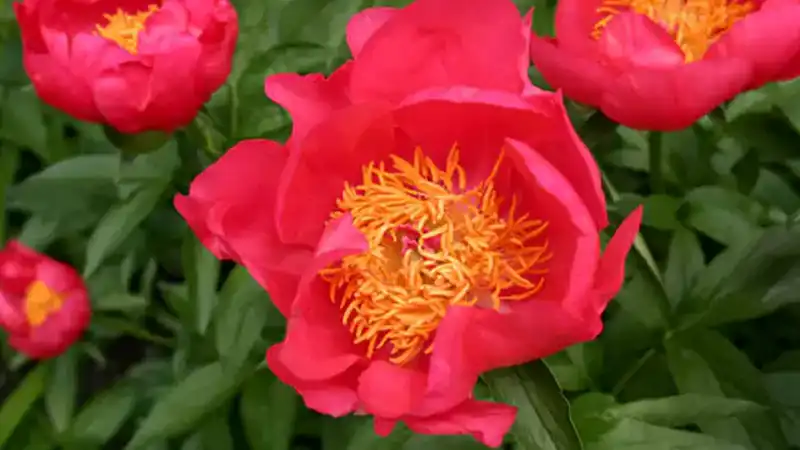
With bright orange and red petals, Flame Peony gives a burning fire look. These cup-shaped flowers have wide petals and golden-yellow stamens. When they bloom in late spring to early summer, the flower is showered with sunlight, which adds to the enchanting atmosphere.
| Common Name | Paeonia lactiflora Flame Peony, Chinese Herbaceous Peony, Chinese Peony, and Common Garden Peony |
| Botanical Name | Paeonia ‘Flame’ |
| Plant Family | Paeoniaceae |
| Plant Type | Perennials, Shrubs |
| Mature Size | 2-3 ft. tall, 2-3 ft. wide |
| Native Regions | Asia, Europe, and Western North America |
| Toxicity | Toxic to dogs, cats, and horses |
Treasure Flower
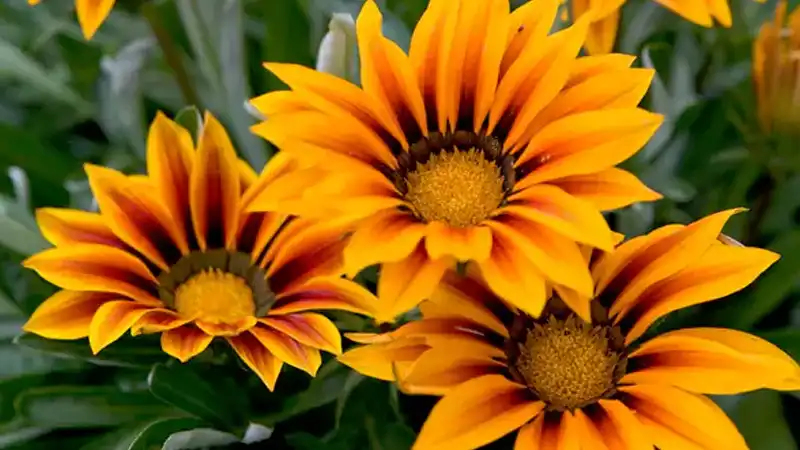
Treasure Flower Gazania, with their yellow-orange fire hues, are low-maintenance flowers that bloom in mid or late spring. They have a daisy-like head and attract butterflies due to their prolific blooming, which is enough to make your garden a paradise. Gazania can be found in different varieties and colors.
| Common Name | Gazania, treasure flower, and African daisy |
| Botanical Name | Gazania rigens |
| Plant Family | Asteraceae |
| Plant Type | Perennial, herbaceous |
| Mature Size | 1 ft. tall, 1 ft. wide |
| Native Regions | South Africa |
| Toxicity | Non-toxic to humans and animals |
Celosia Flower
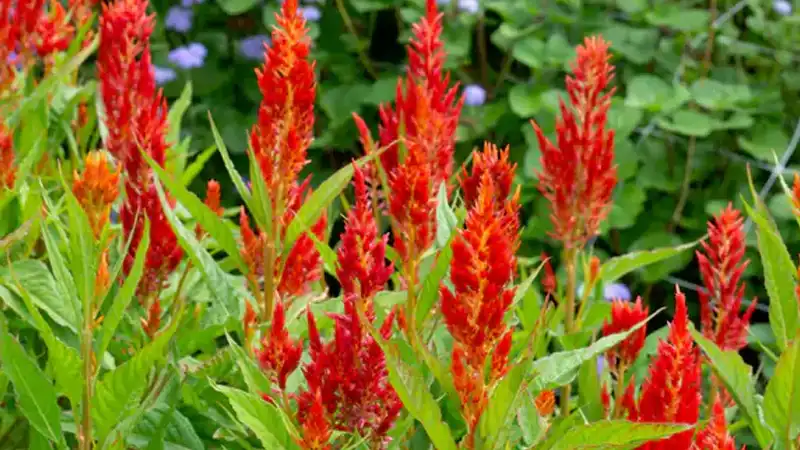
The name Celosia is a Greek word that means burning. These spiky flowers with beautiful bushy foliage change their colors several times. They are a great pollinator that attracts many birds and bees to your garden. Also, the plant leaves are edible and have a spinach-like taste. The best part is that the flower blooms all summer long.
| Common Name | Cockscomb, wool flowers, rooster comb, and velvet flower |
| Botanical Name | Celosia spp. |
| Plant Family | Amaranthaceae |
| Plant Type | Annual |
| Mature Size | 0.3-3 ft tall, 1-2 ft wide |
| Native Regions | Africa, North America, South America |
| Toxicity | Not toxic to humans, cats, and dogs |
Blanket Flower
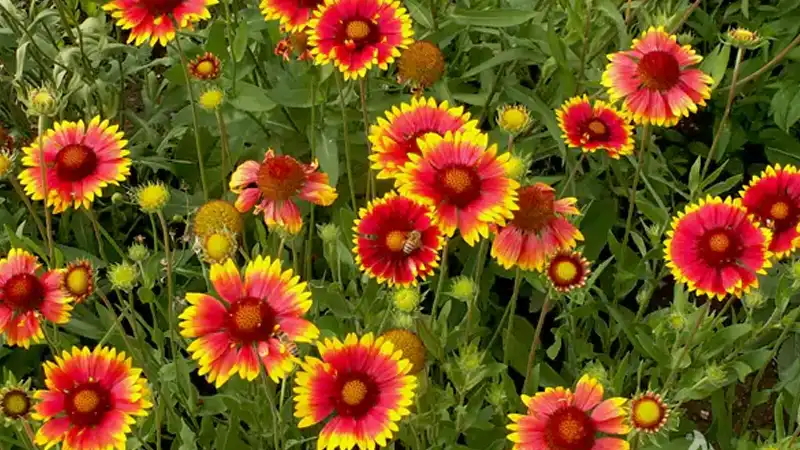
With a daisy-like appearance, Gaillardia are fast-growing, short-lived flowers. Bloom during the warm season months, Blanket Flowers have a brown and red center, filled with nectar that attracts honey bees and butterflies. This amazing fire plant can easily be grown in flower beds, containers, meadows, and lawns. However, Sesquiterpene lactones in these plants can cause skin irritation.
| Common Name | Gaillardia, blanket flower |
| Botanical Name | Gaillardia x Grandiflora |
| Plant Family | Asteraceae |
| Plant Type | Herbaceous perennial |
| Mature Size | 2-3 ft tall, 1-2 ft wide |
| Native Regions | North and South America, including North Carolina |
| Toxicity | Slightly toxic to humans |
Red Hot Poker Plant
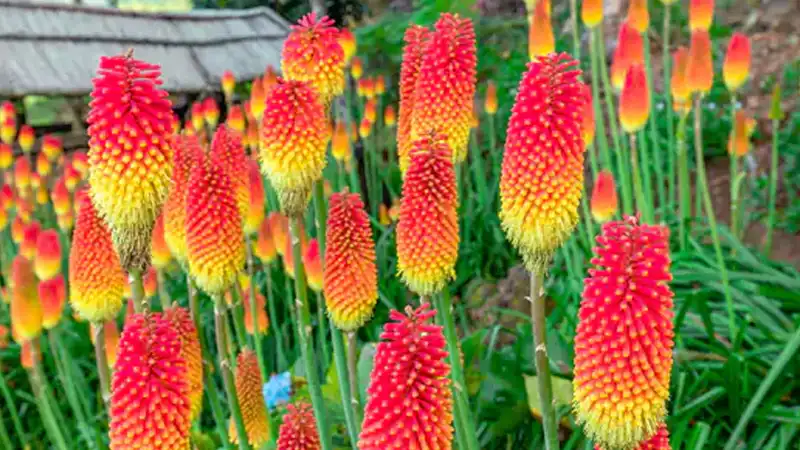
Looking like a bunch of torches lit up in the garden, Red Hot Poker is a tall flower with a tint of yellow, orange, and then deep red from bottom to top. These exotic looks and easy-to-grow plants bloom flowers from late spring to fall and attract hummingbirds, bees, and butterflies. Kniphofia can be found in over 60 different species worldwide.
| Common Name | Red hot poker, torch lily, torch flower, African flame flower, Devil’s poker |
| Botanical Name | Kniphofia |
| Plant Family | Asphodelaceae |
| Plant Type | Herbaceous, perennial |
| Mature Size | 3-4 ft. tall, 2-3 ft. wide |
| Native Regions | South Africa |
| Toxicity | Not toxic for humans and animals |
Red Spider Lily
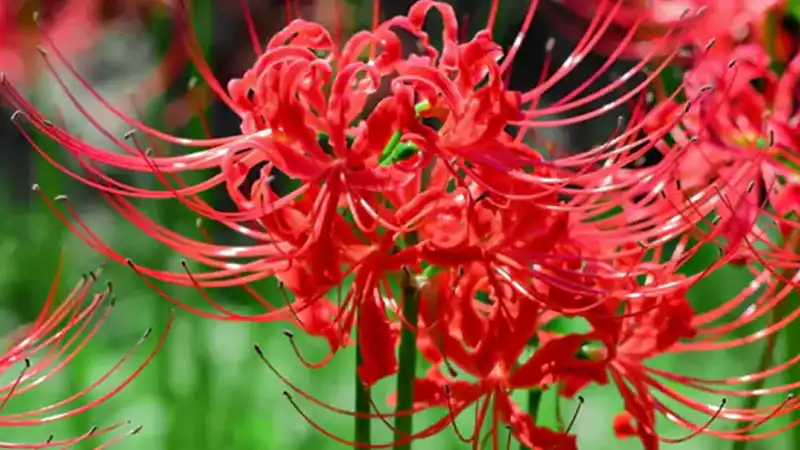
As the name suggests, this plant has bright red petals that look like spider legs. From the appearance, it seems the fire is coming out from the center and dropping downward. While other plants shed their flowers during late summers, a Red Lily is perfect to give a flame atmosphere to your garden throughout winter.
| Common Name | Red spider lily, naked lily, hurricane lily, red magic lily, equinox flower |
| Botanical Name | Lycoris radiata |
| Plant Family | Amaryllidaceae |
| Plant Type | Herbaceous, perennial |
| Mature Size | 1-2 ft. tall, 1-1.5 ft. wide |
| Native Regions | Asia |
| Toxicity | Mildly toxic to humans and pets |
Firecracker Plant
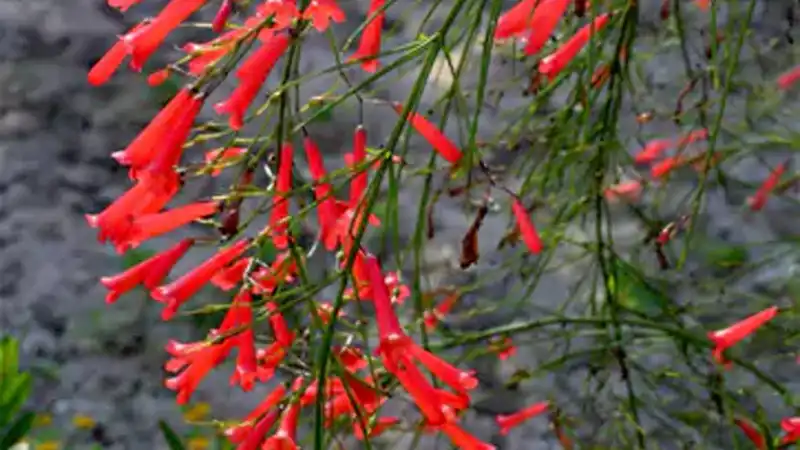
With an appearance like a Firefall, the Firecracker Plant is a cluster of bright and coral-red tubular flowers. Their blossom period is from late spring to fall, and they flourish in full sunlight. This unique shrub will give a splendid look to your walls and raised beds.
| Common Name | Fountain bush, firecracker plant, coral plant, coral fountain, coral blow, or fountain plant |
| Botanical Name | Russelia equisetiformis |
| Plant Family | Plantaginaceae |
| Plant Type | Shrubs |
| Mature Size | 4–5 ft. tall, 2 ft. wide |
| Native Regions | Mexico and Guatemala |
| Toxicity | Not toxic for humans and animals |
Blaze Orange Asiatic Lily
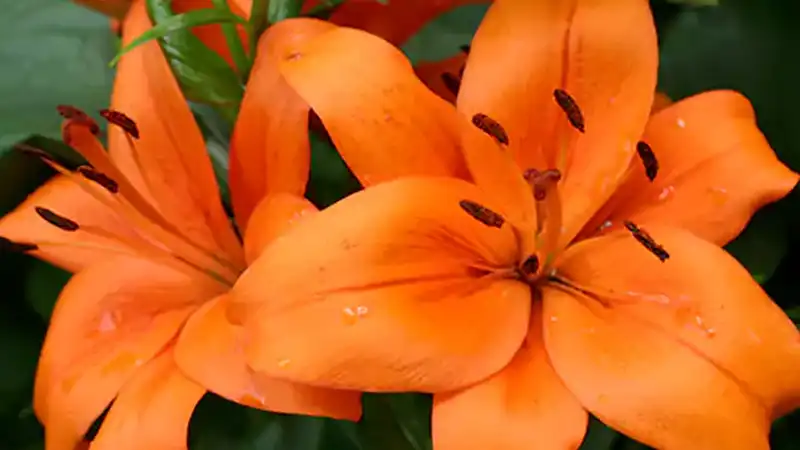
The intense orange hue and curved petals give Blaze Orange Asiatic Lily a spontaneous and fiery impact. These are scentless flowers with tips that seem to be burned. They bloom from May to July and, hence, are a great choice to keep your garden filled with flowers during summer.
| Common Name | Orange lily, Fire lily, Jimmy’s Bane, tiger lily, and St. John’s Lily |
| Botanical Name | Lilium bulbiferum or Lilium ‘Brunello’ |
| Plant Family | Liliaceae |
| Plant Type | Herbaceous perennial bulb |
| Mature Size | 2-4 ft. tall |
| Native Regions | Europe |
| Toxicity | All parts are toxic to cats |
Flame Nasturtium
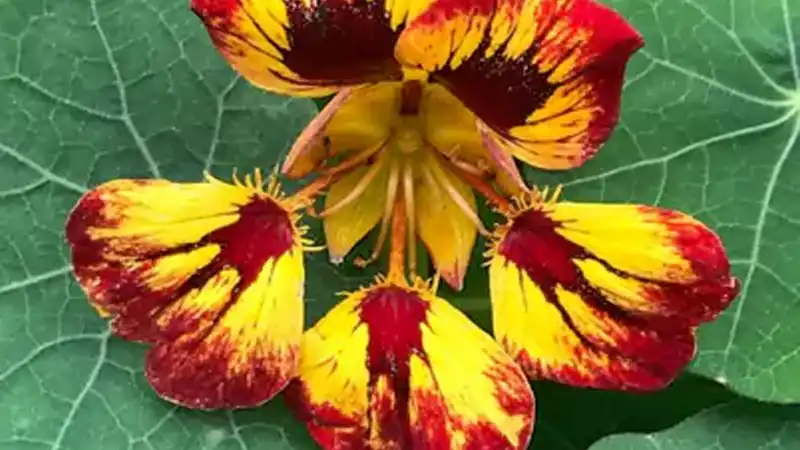
Another star of the show, Flame Nasturtium blooms from summer to fall followed by sapphire blueberries in autumn. This herbaceous climber plant has funnel-shaped flowers of red color. These Flame Flowers add a tropical touch to your lovely garden and attract bees, butterflies, and hummingbirds.
Flame Nasturtium has received the Royal Horticultural Society’s Award of Garden Merit and is also called the ‘Glory of the Highlands’ in Scotland.
| Common Name | Flame flower, flame nasturtium, coralito, quintralito, voqui |
| Botanical Name | Tropaeolum speciosum |
| Plant Family | Tropaeolaceae |
| Plant Type | Climbers |
| Mature Size | 8-10 ft tall, 3-4 ft wide |
| Native Regions | South and Central America |
| Toxicity | Seeds and some parts may be poisonous to humans and pets. |
Lucifer Canna Lily
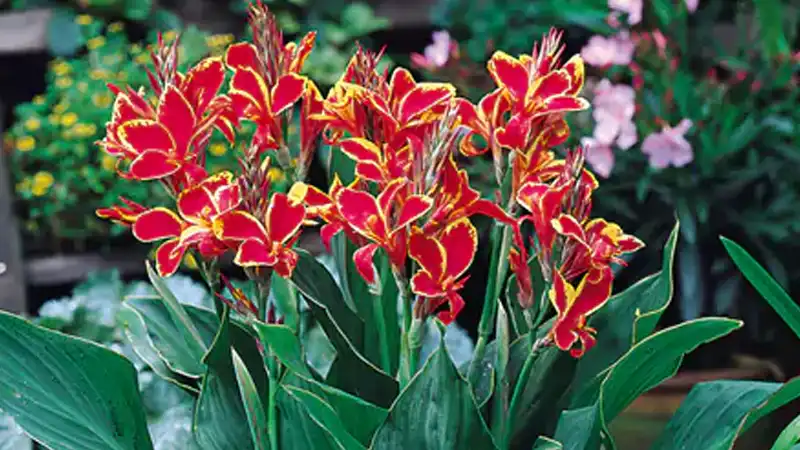
Lucifer Canna Lily, with its iris-like red flowers and golden-yellow edges, is considered the ideal plant for borders and beds due to its vibrant, exotic appearance. They blossom from mid-summer to fall but are highly sensitive to frost. Canna’s true fire effect will attract numerous pollinators to the garden.
| Common Name | Canna Lucifer, Golden Lucifer, Canna Lily |
| Botanical Name | Canna × generalis ‘Lucifer’ |
| Plant Family | Cannaceae |
| Plant Type | Perennials |
| Mature Size | 2-3 ft tall, 1-2 ft wide |
| Native Regions | America, Europe, India, and Africa |
| Toxicity | Non-toxic for humans and animals |
Carnival Dahlia
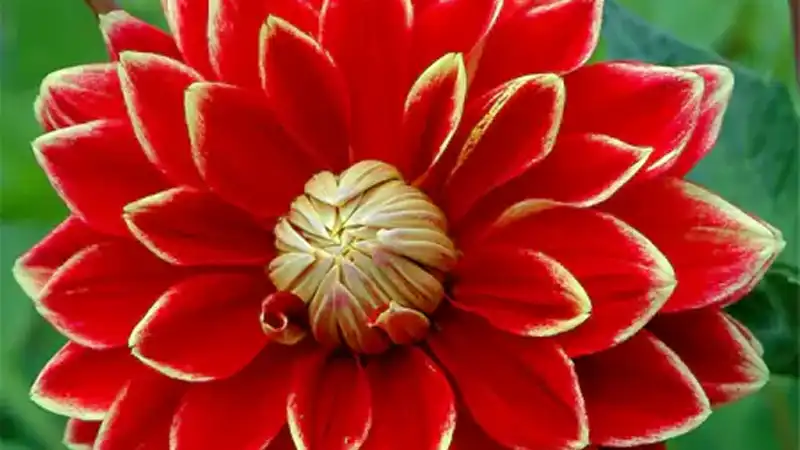
With bright red petals with creamy yellow tips, the Carnival Dahlia has a hardy stem. They are also known as Festivo because they are widely used in bouquets. These Dahlia flowers can embrace your garden, flower beds, and balcony from early July to the first frost, and hence create a mesmerizing autumn display.
| Common Name | Festivo |
| Botanical Name | Dahlia decorative ‘Dutch Carnival’ |
| Plant Family | Asteroideae |
| Plant Type | Tuberous perennials |
| Mature Size | 2-3 ft tall, 1.5-2 ft wide |
| Native Regions | Higher elevations in Mexico and Central America |
| Toxicity | Toxic to humans and dogs |
Zinnia Elegans
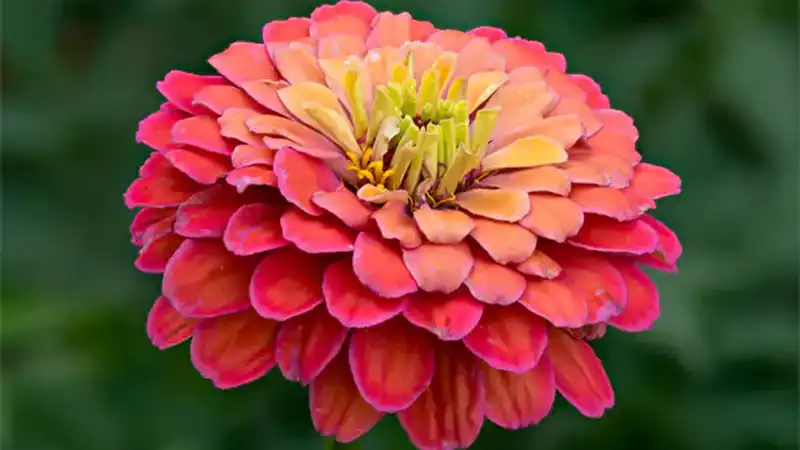
Zinnia Elegans are dahlia-shaped edible flowers with no fragrance. Their bloom time is from June to frost and have multicolor textures. The rose center with red petals surroundings gives a true fire touch to the flower. These low-maintenance, bright flowers attract pollinators and are suitable for beds, borders, and pots.
| Common Name | Zinnia, yellow flame |
| Botanical Name | Zinnia Elegans or Zinnia violacea |
| Plant Family | Asteraceae |
| Plant Type | Annuals |
| Mature Size | 1-4 ft tall, 0.6-2 ft wide |
| Native Regions | Mexico, South America, and Southwest USA |
| Toxicity | Not toxic to humans and pets |
Campfire Flame Bidens Hybrid
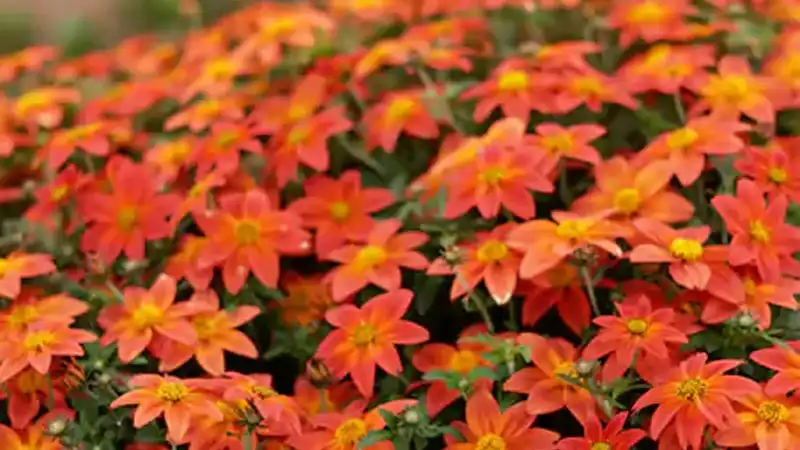
With hues of fiery red and orange and a flame-like shape, the Campfire Flame Bidens Hybrid is one of the best choices of fire plants to enhance the beauty of your garden. The flowers have a deep yellow center, in contrast to the cooler green foliage. Bidens are extremely heat tolerant and bloom from early summer to late fall.
| Common Name | Campfire Flame Bidens, cobbler’s pegs, Spanish needles |
| Botanical Name | Bidens ferulifolia |
| Plant Family | Asteraceae |
| Plant Type | Annual, perennial |
| Mature Size | 0.6-1.2 ft tall, 0.8-1 ft wide |
| Native Regions | United States, Canada, Asia, Africa, and some parts of Europe and Polynesia |
| Toxicity | Edible in nature and hence not toxic to humans and animals. |
Pansy Swiss Giant Flame Flowers
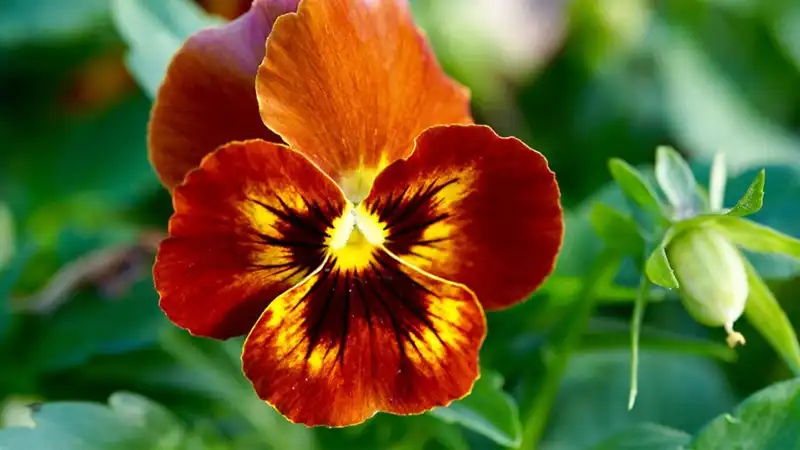
Having the vibrant impression of flames, Pansy Swiss Giant Flame Flowers give an awe-struck look to your garden. The flower has red petals with black blotches and a yellow center. They provide an all-season dazzling display and bloom during early winter.
| Common Name | Giant Pansy |
| Botanical Name | Viola x Wittrockiana, Swiss Giant Flame |
| Plant Family | Violaceae |
| Plant Type | Hardy annual |
| Mature Size | 0.5 ft tall, 0.5 ft wide |
| Native Regions | Switzerland |
| Toxicity | Not toxic for any age group |
Conclusion
We got to know about some unbelievable flowers that look like fire and are the perfect fit to give your garden, balcony, lawns, and pathways an eye-stunning look with a tint of peace and fragrance. They will not just add beauty to the place but will also spread energetic vibes in the environment.
So, this season, make your garden a vibrant world of flowers, and let the fire bloom everywhere!
What are the fire-like red flowers that I can grow in my garden?
Red Flame Celosia, Flame Peony, Red Hot Poker Plant, Red Spider Lily, and others.
What are some annual flowers that look like flames?
Celosia Flower, Zinnia Elegans, Campfire Flame Bidens Hybrid, Plumosa-type blooms, and many others.
What are some perennial flowers that look like fire?
Flame Peony, Flame Lily, Treasure Flower, Blanket Flower, Red Spider Lily, and so on.
Are there any purple flowers that look like fire?
Yes, the Purple Flame Iris (Iris versicolor ‘Purple Flame’) looks like a flame.
Gloriosa lily, Gloriosa superba, Wisconsin Horticulture – Division of Extension
Celosia | UMN Extension, University of Minnesota Extension
Gazania Rigens, Wikipedia